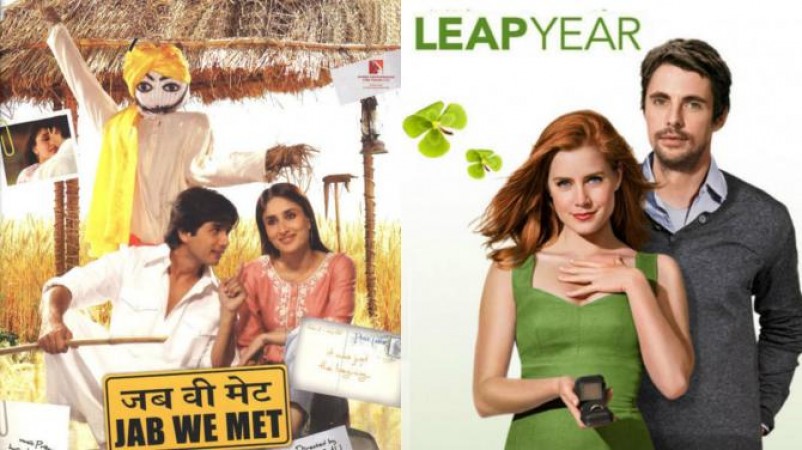
Hollywood has a history of obtaining inspiration from a variety of sources, and a lot of times, this inspiration can be linked to movies from various international locations. The 2010 Hollywood romantic comedy "Leap Year," starring Amy Adams and Matthew Goode, is one such example. It is eerily similar to the Imtiaz Ali-helmed Bollywood smash "Jab We Met," which was a box office success in 2007. Although "Leap Year" isn't necessarily a remake of "The Big Lebowski," there are too many similarities for anyone to ignore. We'll examine the similarities and differences between these two films in this article, highlighting how "Leap Year" was greatly influenced by "Jab We Met."
"Leap Year" and "Jab We Met" share a common romantic comedy plot device in common: a journey that results in an unexpected love interest. Amy Adams portrays Anna Brady in the movie "Leap Year," a Boston real estate stager who chooses to pop the question to her boyfriend on February 29th in accordance with an Irish custom that permits women to do so on this day. As she attempts to get to Dublin, where her boyfriend is attending a conference, her journey, however, takes an unexpected turn.
Similar to this, in the movie "Jab We Met," the plot centers on Geet Dhillon, played by Kareena Kapoor Khan, a lively and vivacious young woman who misses her train and finds herself traveling with Aditya Kashyap, played by Shahid Kapoor. Geet's journey is full of setbacks and unexpected detours, much like Anna's in "Leap Year," but it ultimately results in a strong bond between the two protagonists.
The main characters in the two movies are each given distinct personalities, which is one of their most striking parallels. Both Kareena Kapoor Khan's Geet and Amy Adams' Anna have a number of similar characteristics. They are both independent, tenacious, outspoken women who do not back down from a challenge. Additionally, they have a tendency to make rash decisions, which frequently results in humorous and dramatic situations during their individual journeys.
On the other hand, Shahid Kapoor's Aditya in "Jab We Met" and Matthew Goode's Declan in "Leap Year" both portray the role of the initially reluctant and grumpy male counterpart who eventually falls for the charms of the female lead. From being irritated by the female protagonists to falling madly in love with them, these male characters go through a significant period of character growth.
The use of setting and cultural components to enhance the plot is another feature that highlights the similarities between the two movies. The journey of Anna and Declan in "Leap Year" is set against the beautiful Irish landscapes, which also serve as a backdrop for the story's depiction of Irish traditions and customs. The film expertly captures the spirit of Ireland, from its picturesque villages to its verdant countryside.
In "Jab We Met," the environment is also very important. Geet and Aditya travel by train through the heartland of India, which highlights the diversity and cultural diversity of the nation. The film incorporates aspects of Indian tradition, music, and culture, which gives the characters and plot more depth.
In a similar way, "Leap Year" and "Jab We Met" both explore the themes of self-discovery and love. Despite coming from very different places and living in very different situations, Anna and Geet both want more out of life. Along the way, they discover unexpected love and gain a better understanding of who they are.
In "Leap Year," Anna initially considers the proposal to be the most significant event in her life, but as she navigates the difficulties along the way, she learns that there is more to life than a ring. In a similar vein, Geet in "Jab We Met" is searching for herself and her true calling, and meeting Aditya makes her realize the value of listening to one's heart.
While "Leap Year" heavily borrows from "Jab We Met," it's important to recognize the variations that give each movie its own identity. Irish tradition and culture are included in "Leap Year" in a way that they are not in "Jab We Met." In addition, "Jab We Met" places a greater emphasis on family dynamics and the idea of destiny than "Leap Year" does.
Finally, despite not being an official remake of "Jab We Met" (2007), "Leap Year" (2010) is undeniably heavily influenced by the Bollywood classic. The movie "Leap Year" borrows a number of crucial components from its Indian counterpart, from the plot parallels to the character similarities, as well as the use of the setting and cultural elements. However, the two movies differ from one another due to their distinct charm and cultural quirks. In the end, watching both films is a delightful experience that celebrates the universal themes of love and self-discovery, whether you're a fan of Bollywood romance or Hollywood comedy.
Using Personal Boxers to Define Sid Mehra in 'Wake Up Sid'
Esha Deol's Unexpected Departure and Isha Koppikar's Entry in 'Aamdani Atthanni Kharcha Rupaiya'